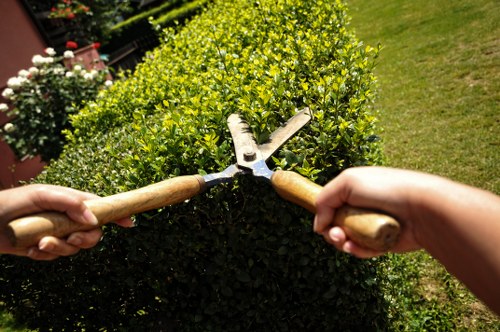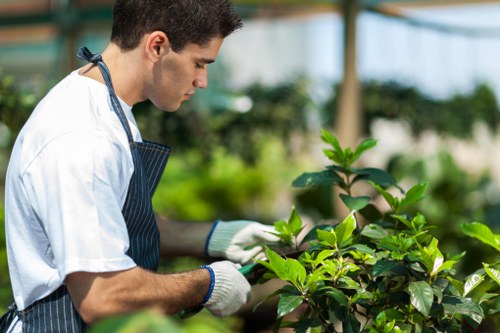Effective Driveway Algae Removal in Waddon

Driveway algae can be an unsightly problem for homeowners in Waddon. Not only does it affect the appearance of your property, but it can also make your driveway slippery and hazardous. Understanding the causes and effective removal methods is essential to maintain a safe and attractive driveway.
Algae thrives in damp, shaded areas, making certain driveways more susceptible, especially after heavy rains or in humid seasons. Without timely intervention, algae can become a persistent issue, requiring professional assistance to fully eradicate.
Addressing algae growth promptly helps prevent damage to your driveway surface and reduces the risk of slips and falls. In this article, we’ll explore various methods for removing algae from driveways in Waddon, ensuring your property remains pristine and safe.
The Causes of Algae Growth on Driveways

Algae growth on driveways is primarily caused by moisture and shade. These conditions create an ideal environment for algae to thrive. Common factors contributing to algae growth include:
- Moisture: Persistent dampness from rainwater or poor drainage.
- Shade: Areas with limited sunlight provide favorable conditions for algae.
- Organic Matter: Accumulation of leaves and debris can trap moisture.
- Surface Porosity: Porous driveway materials can retain moisture, promoting algae growth.
Understanding these factors is crucial for preventing future algae issues and maintaining a clean driveway.
Addressing the root causes can significantly reduce the likelihood of algae resurgence, ensuring long-term maintenance of your driveway’s appearance and safety.
Natural and Chemical Algae Removal Methods

When tackling algae on your driveway, you have a choice between natural and chemical removal methods. Each approach has its advantages and considerations:
Natural Methods
- Vinegar Solution: Vinegar is a non-toxic option that can effectively kill algae.
- Bleach Treatment: A diluted bleach solution can remove stubborn algae but requires careful handling.
- Pressure Washing: High-pressure water can physically remove algae without chemicals.
Natural methods are often preferable for environmentally conscious homeowners and those seeking safer alternatives for family and pets.
Chemical Methods
- Algaecides: Specialized chemical treatments designed to eliminate algae growth.
- Muriatic Acid: A potent cleaner that can effectively remove algae but must be used with caution.
Chemical methods are typically faster and more effective for severe algae infestations but require proper safety measures.
Step-by-Step Guide to Removing Algae

Removing algae from your driveway involves a systematic approach to ensure effectiveness and prevent recurrence. Here’s a step-by-step guide:
- Preparation: Clear the driveway of debris, leaves, and other organic matter.
- Choose a Removal Method: Select either a natural or chemical method based on your preference and the severity of the algae.
- Apply the Cleaning Solution: Whether using vinegar, bleach, or a commercial algaecide, apply the solution evenly across the affected areas.
- Allow Time to Work: Let the solution sit for the recommended time to effectively kill the algae.
- Scrub the Surface: Use a stiff brush to remove the dead algae from the driveway surface.
- Rinse Thoroughly: Wash away the cleaning solution with plenty of water to prevent residue buildup.
- Prevent Future Growth: Improve drainage, increase sunlight exposure, and regularly clean your driveway to deter algae.
Following these steps will help ensure that your driveway is free from algae and maintained in good condition.
Consistency in maintenance can prolong the cleanliness of your driveway and reduce the need for frequent removal efforts.
Preventative Measures to Keep Algae at Bay

Prevention is key to avoiding future algae problems on your driveway. Implementing the following measures can help keep algae growth under control:
- Improve Drainage: Ensure that water does not pool on your driveway by addressing drainage issues.
- Trim Surrounding Vegetation: Reduce shade by trimming trees and shrubs near your driveway.
- Seal the Driveway: Applying a sealant can make the surface less hospitable to algae.
- Regular Cleaning: Sweep and rinse your driveway regularly to remove debris and moisture.
- Use Algal-Resistant Materials: Consider using driveway materials that are less prone to algae growth.
Implementing these preventative measures can significantly reduce the chances of algae returning, saving you time and effort in the long run.
Healthy driveway maintenance practices contribute to the overall longevity and aesthetic appeal of your property.
Choosing the Right Algae Removal Service in Waddon

Opting for professional algae removal services can ensure a thorough and efficient solution. When selecting a service in Waddon, consider the following factors:
- Experience and Expertise: Look for companies with a proven track record in algae removal.
- Eco-Friendly Options: Choose services that offer environmentally safe cleaning solutions.
- Customer Reviews: Check testimonials and reviews to gauge customer satisfaction.
- Pricing: Compare quotes to find a service that offers good value for money.
- Guarantees: Prefer services that provide warranties or satisfaction guarantees.
Hiring the right professionals ensures that the algae removal process is handled correctly, preventing potential damage to your driveway.
Investing in quality services can lead to long-term benefits and peace of mind.
Local Regulations and Environmental Considerations

When removing algae, it’s important to be aware of local regulations and environmental impact. In Waddon, certain chemicals may be restricted, and proper disposal methods must be followed to protect the environment.
- Check Local Laws: Ensure that the methods and chemicals you use comply with local regulations.
- Eco-Friendly Practices: Opt for biodegradable and non-toxic cleaning agents to minimize environmental impact.
- Water Conservation: Use water-efficient methods to reduce waste during the cleaning process.
Adhering to these considerations not only keeps your driveway clean but also contributes to the overall environmental well-being of the Waddon area.
Responsible algae removal practices support sustainable living and community health.
Maintenance Tips for a Long-Lasting Clean Driveway

Maintaining a clean driveway requires regular upkeep and proactive measures. Here are some tips to keep your driveway algae-free for longer:
- Regular Inspection: Periodically check your driveway for signs of algae growth.
- Prompt Cleaning: Address any algae spots as soon as they appear to prevent spreading.
- Enhance Sunlight Exposure: Trim overhanging branches to allow more sunlight to reach the driveway.
- Seal Your Driveway: Apply a sealant annually to create a protective barrier against moisture.
- Use Dehumidifiers: In shaded areas, consider using outdoor dehumidifiers to reduce moisture levels.
Consistent maintenance not only keeps your driveway looking good but also extends its lifespan by preventing damage caused by algae and moisture.
Taking proactive steps ensures that your driveway remains safe and visually appealing throughout the year.
Benefits of a Clean Driveway

Keeping your driveway free from algae offers several benefits, including:
- Enhanced Curb Appeal: A clean driveway improves the overall appearance of your property.
- Increased Safety: Removing algae reduces the risk of slippery surfaces and accidents.
- Preserved Driveway Surface: Regular cleaning prevents deterioration and extends the driveway’s lifespan.
- Higher Property Value: Well-maintained driveways can contribute to higher property valuations.
- Environmental Health: Reducing algae growth helps maintain a healthier local ecosystem.
These benefits make algae removal a worthwhile investment for any homeowner in Waddon.
Achieving a clean and safe driveway enhances both the functionality and beauty of your home.
Conclusion

Driveway algae removal in Waddon is essential for maintaining the safety and aesthetic appeal of your property. By understanding the causes, choosing the right removal methods, and implementing preventative measures, you can effectively manage and prevent algae growth.
Whether you opt for natural or chemical solutions, or decide to enlist professional services, taking proactive steps ensures a long-lasting clean driveway. Regular maintenance and adherence to environmental considerations further enhance the benefits, providing a safe and attractive entrance to your home.
Investing in algae removal not only improves your driveway’s appearance but also contributes to the overall well-being of your property and community.
Frequently Asked Questions

1. What are the best natural methods for removing driveway algae?
Vinegar solutions, baking soda mixtures, and pressure washing are effective natural methods for removing driveway algae. These options are eco-friendly and safe for the environment.
2. How often should I clean my driveway to prevent algae growth?
Regular cleaning, ideally once every few months, helps prevent algae buildup. Additionally, addressing spills and debris promptly can reduce moisture and organic matter that foster algae growth.
3. Can I use commercial algaecides on my driveway?
Yes, commercial algaecides are effective for treating severe algae infestations. It’s important to follow the manufacturer’s instructions and consider environmental impacts when using these products.
4. How can I improve drainage around my driveway to reduce algae?
Ensuring proper slope away from the driveway, installing gutters, and using permeable materials can improve drainage and reduce moisture accumulation, thereby limiting algae growth.
5. Is it necessary to seal my driveway after removing algae?
Sealing your driveway after algae removal creates a protective barrier against moisture and organic matter, helping to prevent future algae growth and prolonging the driveway’s cleanliness.


